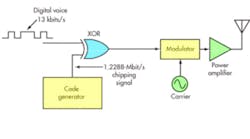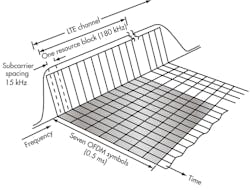Fundamentals of Communications Access Technologies: FDMA, TDMA, CDMA, OFDMA, and SDMA
This article is part of the Communication Series: What’s the Difference: Serial Communications 101
Access methods are multiplexing techniques that provide communications services to multiple users in a single-bandwidth wired or wireless medium. Communications channels, whether they’re wireless spectrum segments or cable connections, are expensive. Communications services providers must engage multiple paid users over limited resources to make a profit. Access methods allow many users to share these limited channels to provide the economy of scale necessary for a successful communications business. There are five basic access or multiplexing methods: frequency division multiple access (FDMA), time division multiple access (TDMA), code division multiple access (CDMA), orthogonal frequency division multiple access (OFDMA), and spatial division multiple access (SDMA).
Each one of these takes advantage of multiplexing methods, dividing the bandwidth of the signal into different sub-bands, which are then assigned to different users in order to allow multiple users to share a single channel. Multiplexing is a communications technique that multiplexes, or combines, multiple signals into a single signal. The reverse process is called demultiplexing. For example, the voice signals of many telephone callers can be multiplexed over a single data link by using time-division multiplexing (TDM).
The multiplexing methods for FDMA, TDMA, CDMA, OFDMA, and SDMA are all generally similar. In each case, a plurality of communication channels is multiplexed together to form a single communication channel. The communication channels are then divided into a plurality of sub-channels, each of which is assigned to a different user.
Download the Article PDF and Check Out More Serial Communication Articles
Each user is then allocated a time slot in which to transmit data. In FDMA, the time slots are assigned to the users in a sequential fashion. In TDMA, the time slots are assigned to the users in a random fashion. In CDMA, the time slots are assigned to the users based on their code sequences. In OFDMA, the time slots are assigned to the users based on their frequency offsets. In SDMA, the time slots are assigned to the users based on their location. Users can then transmit data in their assigned time slots. The data is then demultiplexed at the receive end and sent to the appropriate user.
Table Of Contents
- Frequency Division Multiple Access (FDMA)
- Time Division Multiple Access (TDMA)
- Code Civision Multiple Access (CDMA)
- Orthogonal Frequency Division Multiple Access (OFDMA)
- Spatial Division Multiple Access (SDMA)
- Other Methods
- References
Frequency Division Multiple Access (FDMA)
FDMA is the process of dividing one channel or bandwidth into multiple individual bands, each for use by a single user (Fig. 1). Each individual band or channel is wide enough to accommodate the signal spectra of the transmissions to be propagated. The data to be transmitted is modulated on to each subcarrier, and all of them are linearly mixed together.
The best example of this is the cable television system. The medium is a single coax cable that is used to broadcast hundreds of channels of video/audio programming to homes. The coax cable has a useful bandwidth from about 4 MHz to 1 GHz. This bandwidth is divided up into 6-MHz wide channels. Initially, one TV station or channel used a single 6-MHz band. But with digital techniques, multiple TV channels may share a single band today thanks to compression and multiplexing techniques used in each channel.
This technique is also used in fiber optic communications systems. A single fiber optic cable has enormous bandwidth that can be subdivided to provide FDMA. Different data or information sources are each assigned a different light frequency for transmission. Light generally isn’t referred to by frequency but by its wavelength (λ). As a result, fiber optic FDMA is called wavelength division multiple access (WDMA) or just wavelength division multiplexing (WDM).
One of the older FDMA systems is the original analog telephone system, which used a hierarchy of frequency multiplex techniques to put multiple telephone calls on single line. The analog 300-Hz to 3400-Hz voice signals were used to modulate subcarriers in 12 channels from 60 kHz to 108 kHz. Modulator/mixers created single sideband (SSB) signals, both upper and lower sidebands. These subcarriers were then further frequency multiplexed on subcarriers in the 312-kHz to 552-kHz range using the same modulation methods. At the receiving end of the system, the signals were sorted out and recovered with filters and demodulators.
Original aerospace telemetry systems used an FDMA system to accommodate multiple sensor data on a single radio channel. Early satellite systems shared individual 36-MHz bandwidth transponders in the 4-GHz to 6-GHz range with multiple voice, video, or data signals via FDMA. Today, all of these applications use TDMA digital techniques.
Time Division Multiple Access (TDMA)
TDMA is a digital technique that divides a single channel or band into time slots. Each time slot is used to transmit one byte or another digital segment of each signal in sequential serial data format. This technique works well with slow voice data signals, but it’s also useful for compressed video and other high-speed data.
A good example is the widely used T1 transmission system, which has been used for years in the telecom industry. T1 lines carry up to 24 individual voice telephone calls on a single line (Fig. 2). Each voice signal usually covers 300 Hz to 3000 Hz and is digitized at an 8-kHz rate, which is just a bit more than the minimal Nyquist rate of two times the highest-frequency component needed to retain all the analog content.
The digitized voice appears as individual serial bytes that occur at a 64-kHz rate, and 24 of these bytes are interleaved, producing one T1 frame of data. The frame occurs at a 1.536-MHz rate (24 by 64 kHz) for a total of 192 bits. A single synchronizing bit is added for timing purposes for an overall data rate of 1.544 Mbits/s. At the receiving end, the individual voice bytes are recovered at the 64-kHz rate and passed through a digital-to-analog converter (DAC) that reproduces the analog voice.
The basic GSM (Global System of Mobile Communications) cellular phone system is TDMA-based. It divides up the radio spectrum into 200-kHz bands and then uses time division techniques to put eight voice calls into one channel. Figure 3 shows one frame of a GSM TDMA signal. The eight time slots can be voice signals or data such as texts or e-mails. The frame is transmitted at a 270-kbit/s rate using Gaussian minimum shift keying (GMSK), which is a form of frequency shift keying (FSK) modulation.
Code Civision Multiple Access (CDMA)
CDMA is another pure digital technique. It is also known as spread spectrum because it takes the digitized version of an analog signal and spreads it out over a wider bandwidth at a lower power level. This method is called direct sequence spread spectrum (DSSS) as well (Fig. 4). The digitized and compressed voice signal in serial data form is spread by processing it in an XOR circuit along with a chipping signal at a much higher frequency. In the cdma IS-95 standard, a 1.2288-Mbit/s chipping signal spreads the digitized compressed voice at 13 kbits/s.
The chipping signal is derived from a pseudorandom code generator that assigns a unique code to each user of the channel. This code spreads the voice signal over a bandwidth of 1.25 MHz. The resulting signal is at a low power level and appears more like noise. Many such signals can occupy the same channel simultaneously. For example, using 64 unique chipping codes allows up to 64 users to occupy the same 1.25-MHz channel at the same time. At the receiver, a correlating circuit finds and identifies a specific caller’s code and recovers it.
The third generation (3G) cell-phone technology called wideband CDMA (WCDMA) uses a similar method with compressed voice and 3.84-Mbit/s chipping codes in a 5-MHz channel to allow multiple users to share the same band.
Orthogonal Frequency Division Multiple Access (OFDMA)
OFDMA is the access technique used in Long-Term Evolution (LTE) cellular systems to accommodate multiple users in a given bandwidth. Orthogonal frequency division multiplexing (OFDM) is a modulation method that divides a channel into multiple narrow orthogonal bands that are spaced so they don’t interfere with one another. Each band is divided into hundreds or even thousands of 15-kHz wide subcarriers.
The data to be transmitted is divided into many lower-speed bit streams and modulated onto the subcarriers. Time slots within each subchannel data stream are used to package the data to be transmitted (Fig. 5). This technique is very spectrally efficient, so it provides very high data rates. It also is less affected by multipath propagation effects.
Spatial Division Multiple Access (SDMA)
SDMA uses physical separation methods that permit the sharing of wireless channels. For instance, a single channel may be used simultaneously if the users are spaced far enough from one another to avoid interference. Known as frequency reuse, the method is widely used in cellular radio systems. Cell sites are spaced from one another to minimize interference.
In addition to spacing, directional antennas are used to avoid interference. Most cell sites use three antennas to create 120° sectors that allow frequency sharing (Fig. 6a). New technologies like smart antennas or adaptive arrays use dynamic beamforming to shrink signals into narrow beams that can be focused on specific users, excluding all others (Fig. 6b).
One unique variation of SDMA, polarization division multiple access (PDMA), separates signals by using different polarizations of the antennas. Two different signals then can use the same frequency, one transmitting a vertically polarized signal and the other transmitting a horizontally polarized signal.
The signals won’t interfere with one another even if they’re on the same frequency because they’re orthogonal and the antennas won’t respond to the oppositely polarized signal. Separate vertical and horizontal receiver antennas are used to recover the two orthogonal signals. This technique is widely used in satellite systems.
Polarization is also used for multiplexing in fiber optic systems. The new 100-Gbit/s systems use dual polarization quadrature phase shift keying (DP-QPSK) to achieve high speeds on a single fiber. The high-speed data is divided into two slower data streams, one using vertical light polarization and the other horizontal light polarization. Polarization filters separate the two signals at the transmitter and receiver and merge them back into the high-speed stream.
Other Methods
A unique and widely used method of multiple access is carrier sense multiple access with collision detection (CSMA-CD). This is the classical access method used in Ethernet local-area networks (LANs). It allows multiple users of the network to access the single cable for transmission. All network nodes listen continuously. When they want to send data, they listen first and then transmit if no other signals are on the line. For instance, the transmission will be one packet or frame. Then the process repeats. If two or more transmissions occur simultaneously, a collision occurs. The network interface circuitry can detect a collision, and then the nodes will wait a random time before retransmitting.
A variation of this method is called carrier sense multiple access with collision avoidance (CSMA-CA). This method is similar to CSMA-CD. However, a special scheduling algorithm is used to determine the appropriate time to transmit over the shared channel. While the CSMA-CD technique is most used in wired networks, CSMA-CA is the preferred method in wireless networks.
Conclusion
So, what is the future of communications access technologies? There is no one-size-fits-all answer to this question, as the future of each communications access technology will depend on the specific requirements of the applications and networks that they are being used for. However, it is generally agreed that FDMA, TDMA, CDMA, OFDMA, and SDMA will all continue to play important roles in communications systems in the future. They will continue to provide higher bandwidths and capacities to meet the needs of businesses and consumers. The trend toward more wireless and mobile communications will continue as well, as these technologies offer more flexibility and increased throughput for future generations.
References
- Frenzel, Louis E., Principles of Electronic Communication Systems, 3rd Edition, McGraw Hill, 2008.
- Gibson, Jerry D., Editor, The Communications Handbook, CRC Press, 1997.
- Skylar, Bernard, Digital Communications, 2nd Edition, Prentice Hall, 2001.
- Tomasi, Wayne, Advanced Electronic Communications Systems, 4th Edition, Prentice Hall, 1998.









